
- Republic of Ireland
- Northern Ireland
- The Titanic
- Wild Atlantic Way
- Abbeys and monasteries
- Distilleries
- Irish national parks
- Lighthouses
- Dark Tourism
- Ireland Car Tours
- Game of Thrones in Ireland
- Haunted castles in Ireland
- Long weekends in Ireland
- Themed tours in Ireland
- Urbex in Ireland
- Irish history
- Languages in Ireland
- Irish personalities
- Irish Sports
- Film and television on Ireland
- Irish clothing
- Irish folklore
- Irish literature
- Irish music
- Christmas in Ireland
- Easter in Ireland
- Halloween in Ireland
- Saint Patrick’s Day
- The Irish Pub
- Irish beers
- Irish whiskeys
- Irish ciders
- Irish cocktails
- Irish breakfast
- Local Irish products
- What to do in Ireland
- Pre-trip preparations in Ireland
- Irish entry documents
- The Irish climate
- Everyday Ireland
- Bed & Breakfast
- Guesthouses
- Irish castles to stay in
- Youth hostels
- Book your accommodation!
- Book your flight!
- Book your car
- Contact us!

The reel is a term used to describe a traditional Irish dance and the music that accompanies it. Very famous in Ireland, the reel quickly triggers ants in the feet, impossible to repress! In general, the Reel is very present at Irish parties, folk dances and crazy music sessions in pubs!

Reel presentation

Irish dancers – © paula sierra
Whether in pubs or on the street, the Reel is above all a popular dance and music, played on all occasions and in all places. With a clearly defined structure, it is written in 4/4 or 2/2 time, and consists of a trill movement with an accent on the first and third beats.
Each musical phrase is played over eight bars, and is based on a question/answer dynamic. In this way, phrase A “questions”, while phrase B “answers”: a typical Irish folk dance game!
The instruments used are often drawn from the pure Irish tradition. Here you can hear the fiddle, uilleann pipe, tin whistle and bodhràn!
The “Reel” dance
The reel is danced in pairs, and is organized in two rows, with men and women facing each other. Highly energetic, this dance calls for supple, fast and lively footwork.
Its difficulty makes it a highly respected discipline. Ireland even organizes reel competitions several times a year, where participants must redouble their efforts to surpass themselves and impress a jury that becomes more demanding every year.
Reel can be danced in ghillies (soft dance shoes) or hard shoes (hard dance shoes).
Planning a trip? Download our free guide!
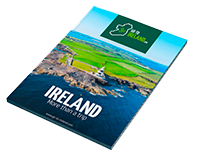
Subscribe to our newsletter and receive our free ebook!
Discover the essentials of the country, its culture, history and must-see sights!
Choose a county!
Find your accommodation in ireland.

The top 8 most Instagrammable places in Northern Ireland

Netflix: the new Bodkin series, filmed in Ireland, is revealed in a tantalizing trailer
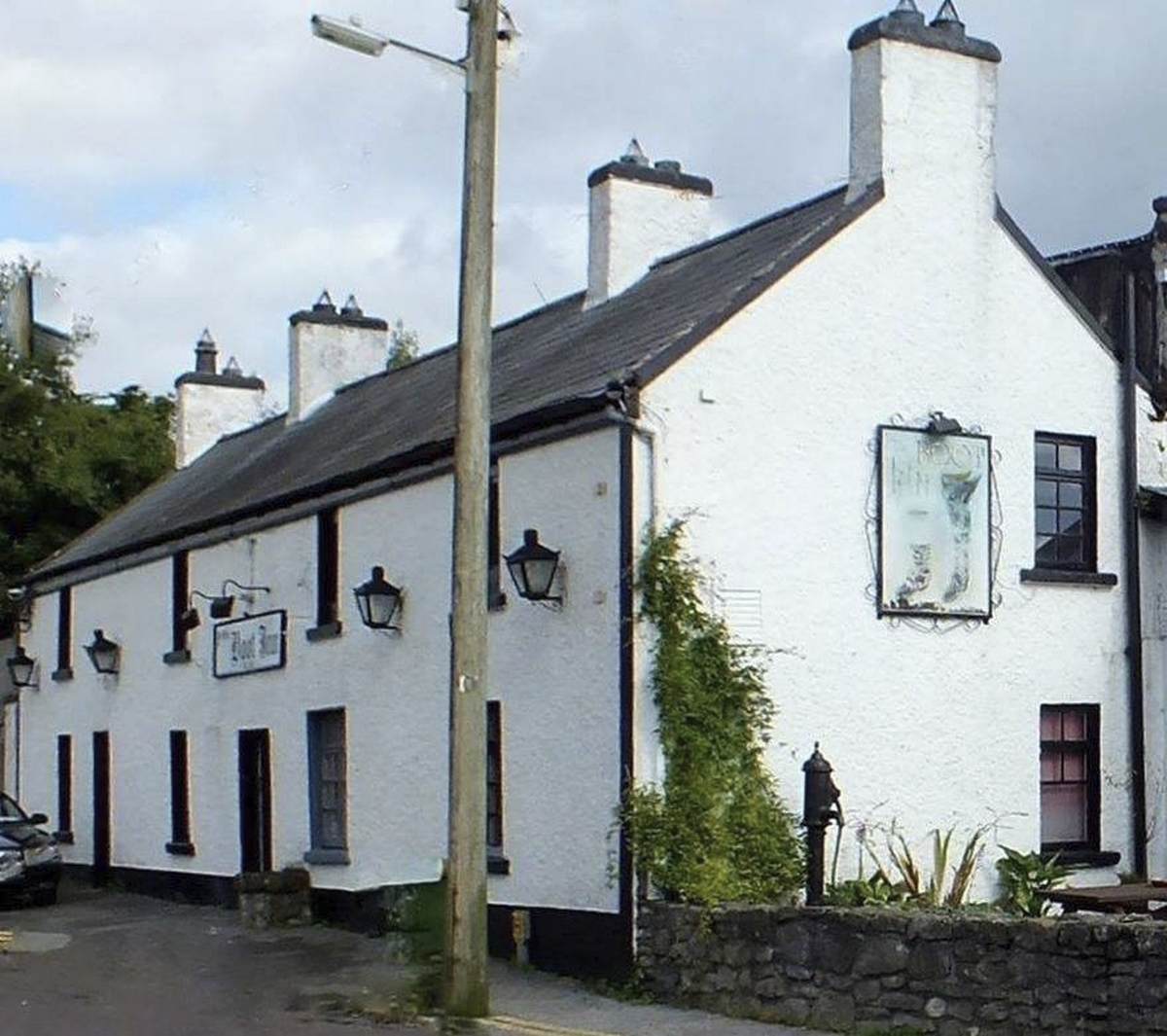
430-year-old Dublin Irish pub closes its doors
with Booking.com
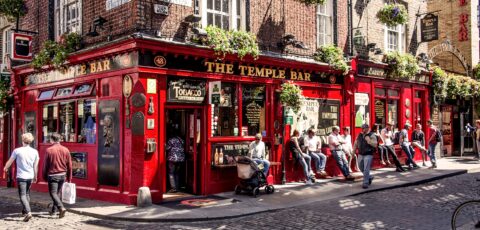
Go to Ireland.com
Our partners.


Are you ready to take your first steps in Irish dance? Whether you’re a complete novice or have some experience in dancing, this ultimate beginner guide will cover everything you need to know about this iconic dance style.
From the history and cultural significance of Irish dance to the basic techniques and steps, you’ll be well on your way to mastering the lively rhythms and intricate footwork that define this beloved art form.
But before we dive into the details, let’s explore why Irish dance is such an exciting and rewarding pursuit.
It is a great way to stay active and improve your fitness level and offers a unique opportunity to connect with rich cultural traditions while expressing yourself through movement.
So whether you’re looking for a new hobby or hoping to compete at the highest levels, read on to discover all there is to know about Irish dance.
Table of Contents
History of Irish Dance
The origins of Irish dance and its evolution are fascinating to explore. The earliest roots of Irish dance can be traced back to pre-Christian times when it was used as a form of storytelling and celebration. As Christianity spread throughout Ireland, the pagan rituals associated with dance were replaced by new religious traditions, but the love for dance remained.
During the 18th century, Irish step dancing began to take shape as we know it today. This style of dancing involves quick footwork and intricate leg movements, with dancers keeping their upper bodies still.
Over time, different styles emerged, such as Sean-nós (old style) dancing, which features a looser and more relaxed approach than traditional Irish step dancing. Other famous Irish dances include ceili (social) dancing and set dancing. Set dances can be performed either individually or in groups.
Understanding the history of Irish dance is an important foundation for any beginner looking to master this art form.
Types of Irish Dance
Irish dance is a vibrant and diverse art form with a rich cultural history. As you delve into the world of Irish dance, it’s essential to understand the various styles and their unique characteristics. Here, we break down the different types of Irish dance, focusing on hard-shoe and soft-shoe dances and the differences between ceili and set dances.
Different Types of Irish Dance
There are many different types of Irish dances. Each type of dance has its own unique flair and rhythm.
Hard shoe dances are characterized by strong percussive movements emphasizing rhythm and timing. Hard shoe dancing has roots in traditional Irish step dancing, which was once performed in everyday footwear. The first hard shoe was made from leather with wooden heels and tips but has evolved over the years to include fiberglass or plastic.
Some popular hard shoe dances include:
- The Hornpipe: A lively dance with a syncopated rhythm, often performed in a 4/4 time signature.
- The Treble Reel: A fast-paced dance with intricate footwork and a focus on the dancer’s ability to create clear, sharp sounds with their shoes.
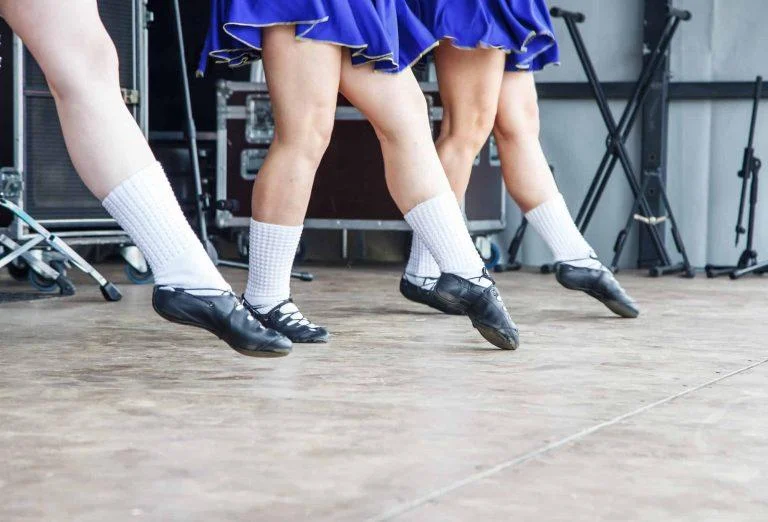
In contrast, soft shoe dances emphasize graceful footwork, where dancers wear flexible leather shoes that allow for more fluid movement. These dances originated from social settings such as weddings and other celebrations where people would gather to dance in their best attire. Soft shoe dancing is also performed as Ceili dancing, focusing on group choreography rather than individual performance.
Some popular soft shoe dances include:
- The Reel: A lively and energetic dance performed in a 4/4 time signature, focusing on smooth footwork and precise timing.
- The Slip Jig: A graceful dance with a 9/8 time signature, often called the “ballet of Irish dance” due to its elegant movements and light, airy feel.
Whether you prefer hard or soft shoe dancing, both styles showcase the history of Irish dance while allowing individuals to express themselves through intricate footwork and rhythmic beats.
Difference Between Celli And Set Dances
How do Ceili and Set dances differ? Both are traditional forms of Irish social dancing.
But, there are some distinct differences between the two.
Ceili dances are group dances performed by four or more couples in a set formation. The dancers move in unison to music played by live musicians, creating intricate patterns and formations on the dance floor.
On the other hand, Set dances are performed by only two or three couples with specific steps and movements unique to each set. In addition, the music for set dances is also typically fast-paced, requiring greater skill and precision from the dancers.
While both types of Irish dance offer numerous benefits, such as increased cardiovascular fitness and improved coordination, it’s important to understand their differences before diving into either.
Basics of Irish Dance
Let’s talk about the basic moves and positions of Irish dance.
First, there’s the ‘reel,’ which involves quick and light movements of the feet and ankles.
For posture and footwork, it’s important to keep your back straight, chin up, and focus on landing softly on the balls of your feet.
Basic Moves and Positions of Irish Dance
In Irish dance, dancers use their entire body to execute precise footwork while maintaining a straight posture and keeping their arms at their sides.
The most basic move in Irish dance is the ‘Over 2-3′ , which involves hopping onto one foot, bringing the other foot up behind it, and then stepping onto that back foot. This step can be done in various directions, such as forward or sideways.
Another important move, commonly known as a ‘shuffle’ or a ‘treble,’ is a popular movement in heavy shoes which involves quickly alternating the feet while creating rhythms.
Irish dance also features several positions essential for executing more advanced moves. One is the ‘first position,’ where the heels are together, and the toes are turned outward.
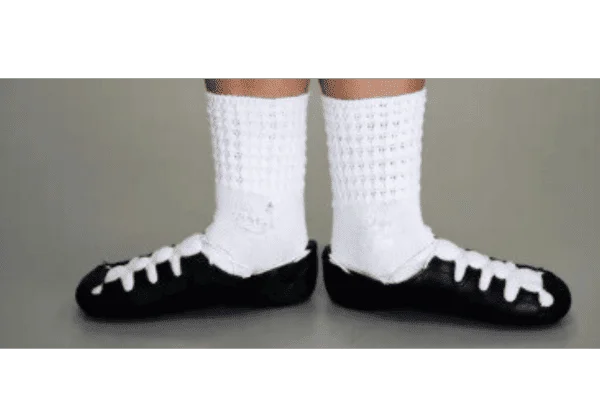
Another common position is the ‘fifth position,’ where one heel is placed in front of the other with both toes pointing outward. These positions may seem simple but require practice to ensure proper form and execution in more complex dances.
You’ll be on your way to becoming an accomplished Irish dancer by mastering these basic moves and positions.
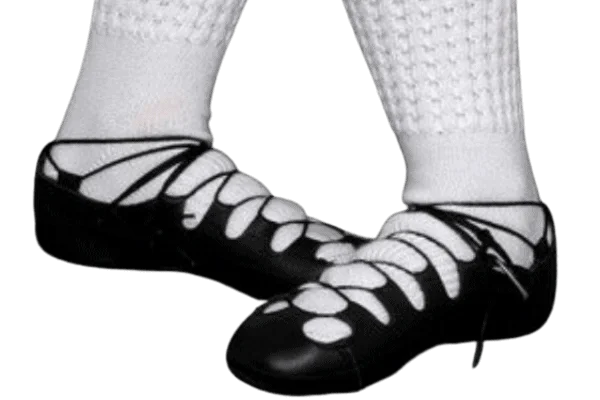
Tips For Proper Posture And Footwork
Maintaining good posture and footwork is essential to Irish dance, as it not only enhances the visual appeal of your performance but also helps prevent injuries.
To achieve proper posture, stand tall with your shoulders back, chin up, and core engaged. Keep your arms relaxed by your sides, your elbows slightly bent, and your hands in a loose fist. Always look straight ahead and avoid tilting your head or hunching over.
Footwork is another crucial aspect of Irish dance that requires precision and coordination. Start practicing basic steps such as the reel or jig with slow and deliberate movements to ensure accuracy.
When performing more complex steps, keep your feet close to the ground while maintaining a light bounce in each step. Remember to keep your weight evenly distributed between both feet and avoid leaning forward or backward.
With practice and dedication, you can master proper posture and footwork in Irish dance for an awe-inspiring performance.
How to Get Started with Irish Dance
Finding a reputable Irish dance instructor is crucial to your success as a beginner. You want someone experienced, knowledgeable, and patient.
Various resources are available to help you find local Irish dance schools, such as online directories, community centers, and word-of-mouth recommendations.
Once you’ve found a class, expect a warm-up, drills for technique, learning choreography, and lots of fun.
Finding A Reputable Instructor
You’ll want to find a trustworthy instructor who can guide you through your journey of learning this exciting and challenging art form.
A reputable instructor will teach you the proper techniques and steps, ensuring you dance safely and avoid injuries. They will also provide valuable feedback on your progress and help motivate you to achieve your goals.
When searching for an Irish dance instructor, look for someone with experience teaching beginners and a strong background in traditional Irish dance.
Be sure to check their credentials and reputation by reading reviews from past students or even asking for recommendations from other dancers in the community.
Ask questions during your initial meeting with them to see if they are a good fit for your learning style and personality.
Finding the right instructor is key to success in any new skill or hobby, so take the time to research before committing to any classes or lessons.
Resources For Finding Local Irish Dance Schools
If you’re on the hunt for local Irish dance schools, plenty of online resources can help you navigate the options.
Here are some resources to help you locate Irish dance schools in your area:
- Online Search: Your search should start with “Irish Dance Near Me.” This will give you a list of local Irish dance schools.
- Our Directory Page: We continually add more Irish Dance Schools to our directory page to help you find a local dance school.
- Regional Irish Dance Associations: Many countries and regions have their own Irish dance associations, such as the An Coimisiún Le Rincí Gaelacha for Ireland , the North American Irish Dance Federation for North America, and the Australian Irish Dancing Association for Australia. These associations often provide information on local Irish dance schools.
- Social Media: Facebook, Instagram, and Twitter can be helpful for finding Irish dance schools in your area. Search for local Irish dance groups, pages, or hashtags to discover nearby schools and classes.
- Local Community Centers and Cultural Organizations: Many community centers, cultural organizations, and Irish heritage centers offer Irish dance classes or can provide information about local dance schools.
- Word of Mouth: Asking friends, family, or coworkers interested in Irish dance is another great way to find local dance schools. They may have personal recommendations or know of schools in the area.
By utilizing these resources, you’ll be well on your way to finding the perfect Irish dance school to start your journey in this captivating art form.
What To Expect In A Typical Irish Dance Class
In a typical Irish dance class, you’ll be swept away by the lively music and intricate footwork that make you feel like you’re part of an exhilarating performance.
The class usually begins with warm-up exercises to prepare your muscles for the intense footwork. You’ll then learn the basic steps, usually broken down into smaller parts so beginners can follow along easily.
Once you’ve mastered the basics, your instructor will move on to more complex steps and combinations. These may include jumps, spins, and partner work. Don’t worry if it seems overwhelming at first; with practice and dedication, you’ll soon be able to keep up with the rest of the class.
In addition to mastering the steps themselves, you’ll also need to work on your posture and overall presentation, as these are important aspects of Irish dance performance. So get ready to sweat, have fun, and become a skilled Irish dancer.
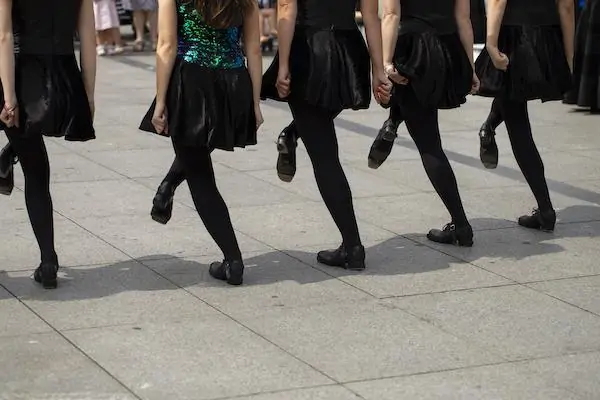
Practice and Training
Practicing at home is an essential part of improving your Irish dance skills. You can start by setting a regular practice schedule that works for you and creating a comfortable space to practice in.
To get the most out of your at-home practices, focus on perfecting the basic steps before moving on to more complicated routines. To progress in Irish dance, taking classes regularly and seeking feedback from teachers or experienced dancers is important.
Also, watch performances and competitions online to see different styles and techniques. Feel free to challenge yourself with new steps or choreography as well. But, you must master the essential basic moves before moving to more advanced steps.
Preparing for performances and competitions requires careful planning and attention to detail. Make sure you have the right shoes, costumes, music, and accessories well in advance. Use your practice time wisely by rehearsing specific routines or sections multiple times until they feel natural.
Remember to focus on your goals and push yourself to perform at your best.
Practicing At Home
You can improve your skills and impress others by practicing at home. The key to successful Irish dance practice is consistency.
Start with setting a regular schedule that works for you, whether it’s 30 minutes every day or an hour twice a week. Then, find a quiet space where you won’t be interrupted and put on some traditional Irish music to get in the mood.
Begin your practice with warm-up exercises, such as stretches and footwork drills, to prepare your body for dancing. Then, perfect basic steps before moving on to more complex routines.
Use mirrors to check your form and posture, paying attention to your arms, feet, and head positioning. Remember to take breaks when needed, but try to maintain focus during practice sessions.
With consistent effort, you’ll see progress in no time.
How To Progress
If you want to improve your skills and take your dancing to the next level, setting goals and developing a plan for progressing is important.
Start by identifying areas where you need improvement—perhaps you need more practice with footwork or better posture during jumps. Once you’ve identified these areas, schedule focused practice time each day.
This might mean practicing for 30 minutes after school or work or scheduling longer blocks on weekends. In addition to setting specific goals for technique and skill development, it’s also important to set broader goals related to performance and competition.
Maybe your goal is to perform in front of an audience within the next six months or compete in a local dance competition within the next year. Whatever your goals, be sure they’re realistic and achievable with consistent effort over time.
By setting clear goals and working towards them consistently, you’ll find yourself making progress faster than ever.
How To Prepare For Performances And Competitions
If you want to be fully prepared for upcoming performances and competitions, it’s important to have a game plan in place well in advance.
This means creating a schedule that includes regular practice sessions, rehearsals with your dance group or partner, and time to perfect your performance routine. In addition, paying attention to your physical fitness by maintaining a healthy diet and getting enough rest is also crucial.
In addition, focus on mental preparation by visualizing yourself performing flawlessly and staying positive throughout the process. Finally, consider recording yourself during practice sessions to review and improve your technique.
Lastly, remember the importance of attire; ensure you have comfortable shoes that fit correctly and appropriate costumes or outfits for each performance.
With these steps in place, you’ll be ready to confidently and easily take on any performance or competition.
Benefits Of Irish Dance
In terms of the physical and mental benefits of Irish dance, you can expect to see improvements in your cardiovascular health, balance, coordination, and overall fitness level.
This dance has been shown to reduce stress and improve cognitive function.
As you continue to learn and practice this Irish dancing, you’ll notice increased confidence and improved social skills through the supportive community surrounding Irish dance.
Physical And Mental Benefits
You’ll feel your body come alive as you move in ways that strengthen your muscles, improve your coordination, and increase your endurance while boosting your mood and reducing stress.
The physical benefits of Irish dance are numerous. As you develop the skills needed to perform intricate footwork and fast-paced movements, you’ll notice improvements in flexibility, balance, and agility. You’ll also build strength in your legs, core, and upper body as you hold positions for extended periods.
But the benefits continue beyond there. Irish dance is not just a physical activity; it’s also a mental workout. As you learn new steps and choreography, you’ll challenge yourself mentally by improving memory retention and increasing focus. Additionally, performing in front of an audience can help boost self-confidence and reduce anxiety.
With all these benefits combined, it’s no wonder Irish dance has become such a popular activity for people looking to improve their physical and mental health.
Build Confidence And Improve Social Skills
You might be surprised to learn that dancing can do more than just benefit your physical and mental health; it can also help you build confidence and improve your social skills.
Irish dance encourages individuality while promoting a sense of community within a team or class. In addition, as dancers progress in their skills, they gain the confidence to perform in front of larger audiences, which can translate into improved public speaking abilities or simply being comfortable in social situations.
Irish dance requires teamwork and communication between dancers. This fosters strong social skills as dancers learn to work together towards a common goal and support each other throughout the learning process.
Whether practicing steps together or performing at competitions, Irish dance creates opportunities for individuals to connect with others who share their passion for dance and music.
Overall, Irish dance is an enjoyable pastime and a great way to develop important life skills such as confidence and social competence.
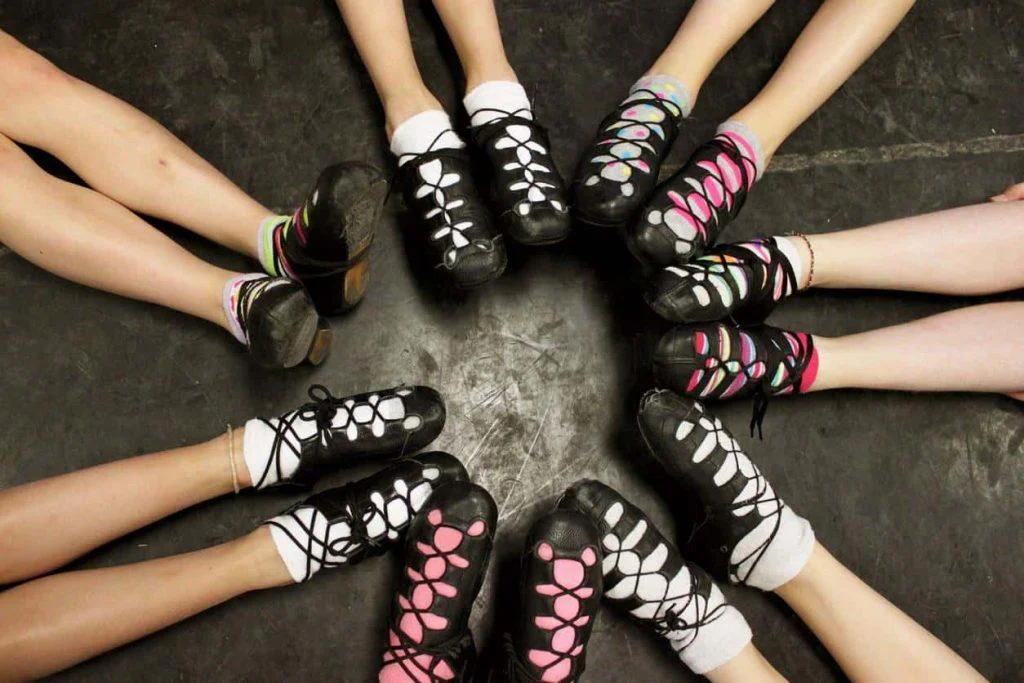
Now that you’ve learned more about this beautiful art form, it’s time to take the leap and try it. Who knows, Maybe you’ll find a new passion or make some amazing friends along the way.
Imagine feeling the adrenaline rush as you perform in front of a cheering crowd or experiencing the joy of nailing that complicated footwork sequence after weeks of practice. Irish dance is not only an excellent workout for your body but also for your mind.
It requires discipline, focus, and repetition to master each step. But, by practicing regularly, you’ll improve your memory skills and build self-confidence. So why not join a class today and start your journey toward becoming an Irish dancer?
Many resources are available online to help you find classes near you or learn more about this fascinating art form. Don’t be afraid to ask questions and seek guidance from experienced dancers – they’ll gladly share their knowledge with you.
Frequently Asked Questions
What is the significance of the costumes worn in irish dance.
When you step onto an Irish dance floor, one of the first things that catches your eye is the stunning costumes worn by dancers. These dresses and outfits are visually striking and hold great significance in the world of Irish dance.
The intricate designs and vibrant colors are meant to represent different regions and styles of Ireland while also showcasing a dancer’s personality and flair. In addition, traditional Irish dance costumes feature hard shoes with unique designs that create a distinct sound when hitting the floor.
As a beginner in Irish dance, understanding the history and meaning behind these costumes can deepen your appreciation for this beautiful art form.
Is Irish dance only for children or can adults participate as well?
You may be surprised to learn that Irish dance isn’t just for children; adults can also participate.
Many adult dancers find the discipline and artistry of Irish dance to be a fulfilling hobby or even a competitive sport.
It’s never too late to start learning the intricate footwork and graceful movements that make up this beautiful form of expression.
Irish dance offers something for everyone, whether you’re looking for a new challenge or simply wanting to connect with your heritage.
So why not give it a try? You might just discover a passion you never knew existed.
How do I find a reputable Irish dance school or teacher?
To find a reputable Irish dance school or teacher, start by asking for recommendations from friends or family who have experience with the dance.
You can also search online for schools in your area and read reviews from former students. Finally, research the credentials of any potential teachers, including their training and performance experience.
It’s important to find a teacher who is skilled and passionate about teaching and creating a positive learning environment. Don’t be afraid to try different schools or teachers until you find the right fit.
Remember that Irish dance is not just for children – plenty of adult dancers are out there, so don’t hesitate to join in on the fun.
Can I participate in Irish dance competitions without joining a school?
You’re eager to compete in Irish dance but don’t want to join a school. The good news is that it’s possible to participate in competitions without being part of a school.
However, it’s important to note that Irish dance competitions are highly regulated and organized by governing bodies. You’ll need to register independently and ensure you meet all the requirements for your age group and level. It can be challenging to navigate this process alone, but you can certainly do it with dedication and persistence.
Remember that joining a reputable school or finding a qualified teacher can provide invaluable guidance and support as you pursue your passion for Irish dance competitions.
What common mistakes do beginners make in Irish dance, and how can I avoid them?
As a beginner in Irish dance, it’s essential to be aware of common mistakes many newcomers make. One mistake is to practice more consistently. It can be tempting only to practice when you have time or feel motivated, but regular practice is crucial for improvement.
Another mistake is neglecting your technique and focusing solely on choreography. While the steps are important, proper technique will help you execute them correctly and more efficiently.
Beginners often need to remember to engage their core muscles, leading to sloppy footwork and poor posture. Therefore, focus on maintaining good form throughout your practice sessions.
By avoiding these common mistakes and staying dedicated to improving your skills, you’ll be well on your way to mastering Irish dance.
So, you’ve finally reached the end of this ultimate beginner guide to Irish dance. Congratulations. You’re now equipped with all the necessary knowledge and skills to kickstart your journey in this iconic dance form.
But don’t let the word ‘beginner’ fool you into thinking that Irish dance is easy. On the contrary, it takes hard work, dedication, and lots of practice to master the intricate footwork and lively rhythms that make Irish dance so beloved worldwide.
However, as you delve deeper into this captivating world of dancing, you’ll discover a plethora of benefits that come with it. You will improve your physical health and mental well-being and develop a sense of cultural appreciation for Ireland’s rich history and traditions.
So go ahead, put on your dancing shoes, and immerse yourself in the lively beats of Irish music. Embrace the challenge with open arms and enjoy every step along the way.
Who knows? One day could be performing on stage in front of thousands or even competing at prestigious competitions like the World Irish Dancing Championships. The possibilities are endless – all it takes is passion, perseverance, and a little luck o’ the Irish.
Irish Dancing World
Terms and Conditions - Privacy Policy
Irish Dance: History And Guide
Categories Culture and Food
Like the Irish language and traditional Irish music, Irish dance is an important element of Ireland’s heritage and culture.
Many Irish children participate in Irish dancing as an extracurricular activity, and it is always prominently displayed during Irish events such as St. Patrick’s Day .
Things you'll find in this article
The Irish Dance
History of the irish dance, irish dance music, irish dance styles, basic dance steps, irish dance types, common attire, irish dance competition.
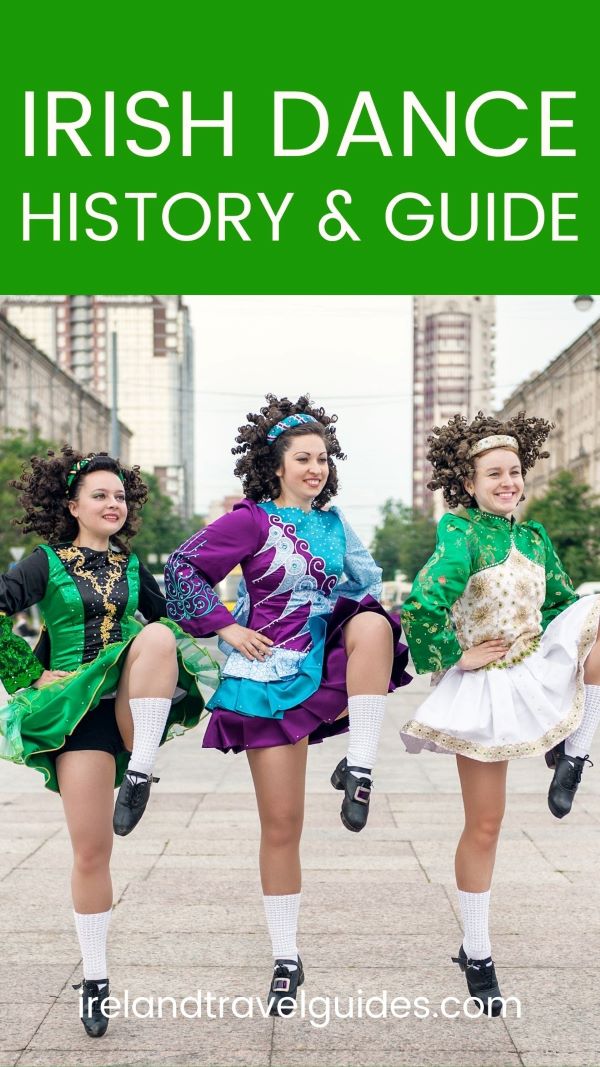
In this guide, we’ll try to cover everything you need to know about Irish Dance.
Traditional Gaelic or Celtic dance traditions developed in Ireland, and are known as Irish dance or Irish dancing. It can be done solo or in groups of up to twenty expert dancers.
Irish dance is primarily a social dance in Ireland, but it can also be used for official performances and competitions.
Irish Dance is notable for the dancers’ rigid upper bodies and sophisticated footwork.
Irish dancers do not use their arms or hands to emphasize their footwork, as they do in other dance disciplines. This is a distinct feature that makes Irish Dance performances fascinating to watch.

Many records from the seventh and eighth century were destroyed by the Vikings , thus there are scant references to the early history of Irish dancing. Early Druids are said to have danced as part of their pagan ceremonies.
Since the Celts arrived from Central Europe some 2000 years ago, dance has played a significant role in festivals.
When Ireland converted to Christianity around 400 AD, music and dance became more popular.
There were literary references to circle dances, dancers in formation, dancers greeting Royalty, as well as singing and dancing to harp or bagpipe music Aristocrats and peasants alike attended the dance, which was regularly performed at wakes.
The modern Irish words for “dance,” rince and damhsa, didn’t appear until the 16th century. The few existing evidence come largely from travelers to Ireland.
One of them was a fourteenth-century hymn penned in the South of England encouraging his audience to “come ant daunce wyt me in Irlande.”
The first native Irish documentary record of dancing is an account of a Mayor of Waterford’ s travel to Baltimore, County Cork in 1413.
There were guests who “went to the floor” to celebrate Christmas Eve.
The Norman invasion in the twelfth century most likely brought the circle dance tradition to Ireland, as it was performed throughout Norman strongholds at the time.
According to seventeenth-century records of dance in Ireland, it was extremely popular at the time. A source from 1600 mentions the “rinnce fada,” also called the “long dance” or “fading.”
This dance, performed to a jig melody rather than a specific piece of music, became the traditional climax of Irish balls at the end of the seventeenth century.
By the 1760s, the Irish dance tradition had developed its hornpipe rhythm, and the entrance of the violin from Europe ushered in a new breed of “dancing master.”
Traditional Irish music and dancing are said to have evolved in lockstep.
It was eventually influenced by European dance traditions, particularly the Quadrille, despite its origins being unknown. Traveling dancing instructors taught across Ireland as late as the 18th and early 19th centuries.
Since local venues were often small, dances were commonly conducted on tabletops or even the tops of barrels.
As a result, these early forms have their arms tightly gripped at the sides and no lateral mobility.
As larger dancing facilities were accessible, styles began to include more body movement and movement around the dance floor.

There is a long tradition of dance music in Ireland. Hundreds of years have passed since some of the dances were performed, bit like oral tradition, the music is memorized and passed down through generations.
Irish Dance music has symmetrical melodies that are usually eight bars long. The following are a few examples of popular Irish dance music:
The reel – The most well-known Irish dance music, the reel is either 2/4 or split common time (a quick 4/4 with primary powerful beats) and has two beats in each bar.
The majority of the movement is done in quavers. Two or three tunes are combined, with each tune being repeated two or three times before going on to the next.
The jig – This Irish Dance music features jumping steps and is dynamic dance. It’s quick and takes a long time to complete.
The most commonly used jig is the double jig. It is written in the 6/8 time signature and frequently employs three-quaver groups. A crotchet terminates the final bar.
- 6/8 or 12/8 for the single jig – A crotchet, followed by a quaver, is the most common rhythm.
- The slip jig – is danced in soft shoes and is in 9/8 time. It has graceful movements.
The hornpipe – The hornpipe moves at a leisurely pace. It is frequently done in heavy shoes and is in 2/4 or 4/4 time with dotted rhythms.
Ballet Up and Flat Down are two dance style methods that are used in many Irish dance types. These techniques illustrate how Irish dancers use their feet in a number of ways.
- Ballet up – This is a balletic style in which the toes are pointed and the steps are taken high on the toes’ balls or tips. In this techniqe, the body’s weight is lifted off the ground.
- Flat Down — This technique stresses a smooth, flat action with the heels. This way, the sound of the metal cleats is amplified as the body’s weight sinks into the floor.
The basic steps of Irish Dance are based on its two major styles or techniques.
- Chasse – It’s based on the Ballet Up technique and means “to chase.” The Irish dancer takes a step with the right foot while the left foot “chases” the right foot in three counts. The “1-2-3” method is commonly used.
- Cabriole – The cabriole is another step from Ballet Up that involves leaping into the air while the left calf beats under the right calf that is extended forward in the air.
- Flat Down – This is an Irish dance step in which a dancer’s right foot twists and shuffles over the floor as the left foot hops into the air.
- Shuffle – This step involves stamping the entire foot and tapping one toe behind the other foot, which bears the weight of the body.
From the two basic techniques, here are the different types of Irish Dance, each with a distinct history and background.
Ceili Dancing – Ceili dancing dates back to the early 1500s in Ireland. It’s a multi-couple folk dance.
Each pair dances with each other as well as the rest of the group, changing partners regularly. Ceili dancing features extended limbs and pointed toes.
Set Dancing – This Irish dance is the country’s version of the quadrille, a traditional court dance. Four couples, arranged in a square, are usually needed to perform this dance.
Then, two couples at a time, go around the square, swapping places. The dancers use the entire flat part of their feet in ceili, with the exception of a few low kicks and flourishes.
Step Dance – Stepdancing is an Irish dance that can be done solo or in groups. The dancers here keep their upper bodies stiff.
Their feet and legs, on the other hand, conduct a sequence of exceedingly fast hops, high kicks, and intricate footwork.
Sean-nós Dancing – Sean-nós is distinguishable from other Irish dances by its footwork, which is parallel and mostly touches the ground.
A relaxed upper body is indicated by swaying hips and arms. Because improvisation is encouraged, Sean-nós is significantly less formal and organized. This dance is also popular among solo dancers.
Irish Dance Costume

Female dancers usually dress up in their “Sunday Best” in the early days of Irish dance, mostly long dresses or skirts paired with blouses.
Male dancers, meanwhile, either wore shirts paired with an Irish clan kilt, or a long coat, shirt, vest, and briques (calf length pants) with leggings.
Clothes worn by Irish dancers have changed over time, and dancers today wear a range of outfits.
- Traditional Celtic dance – Male dancers perform in traditional shirts and kilts, while female dancers wear blouses and long skirts.
- Modern Irish Dance – Female dancers wear short costumes in vibrant colors, and their arms are almost always covered. Trousers and a blouse with a colorful ribbon knotted around the waist are worn by modern Irish male dancers.
Irish dancers’ footwear is determined by the genre of dance they are performing.
- Flat Down step – Male and female dancing shoes contain metal cleats on the toes and heels and are typically black leather oxfords with laces and a leather strap to keep the shoe on the foot.
- Ballet Up dance – Male dancers wear black leather shoes with soft soles for flexibility, while female dancers wear black leather “Ghillies.” Irish dancers can perform dance steps on the balls of their feet or the tips of their toes thanks to the supple leather of Ghillies.
One of the finest ways to appreciate and see Irish dance is to go to competitions. In Ireland alone, there are a slew of tournaments.
Competitions are classified into categories based on their location, age group, and level of expertise, with competitions spanning from local to regional to national.
Ireland’s most prominent regional competition is the ‘Oireachtas.’ During a competition, a dancer’s methods, style, timing, and the sounds they make with their footwork will all be evaluated.
The Irish Dancing Commission founded the annual World Championship of Irish Dancing. In 1950, it began in Dublin but quickly outgrew the city.
The World Championships started in the north of Ireland and ended in the south. From then on, the event increased in popularity and spread over the world.
This competition is still running today, and has attracted more than 6,000 dancers from 30 countries.
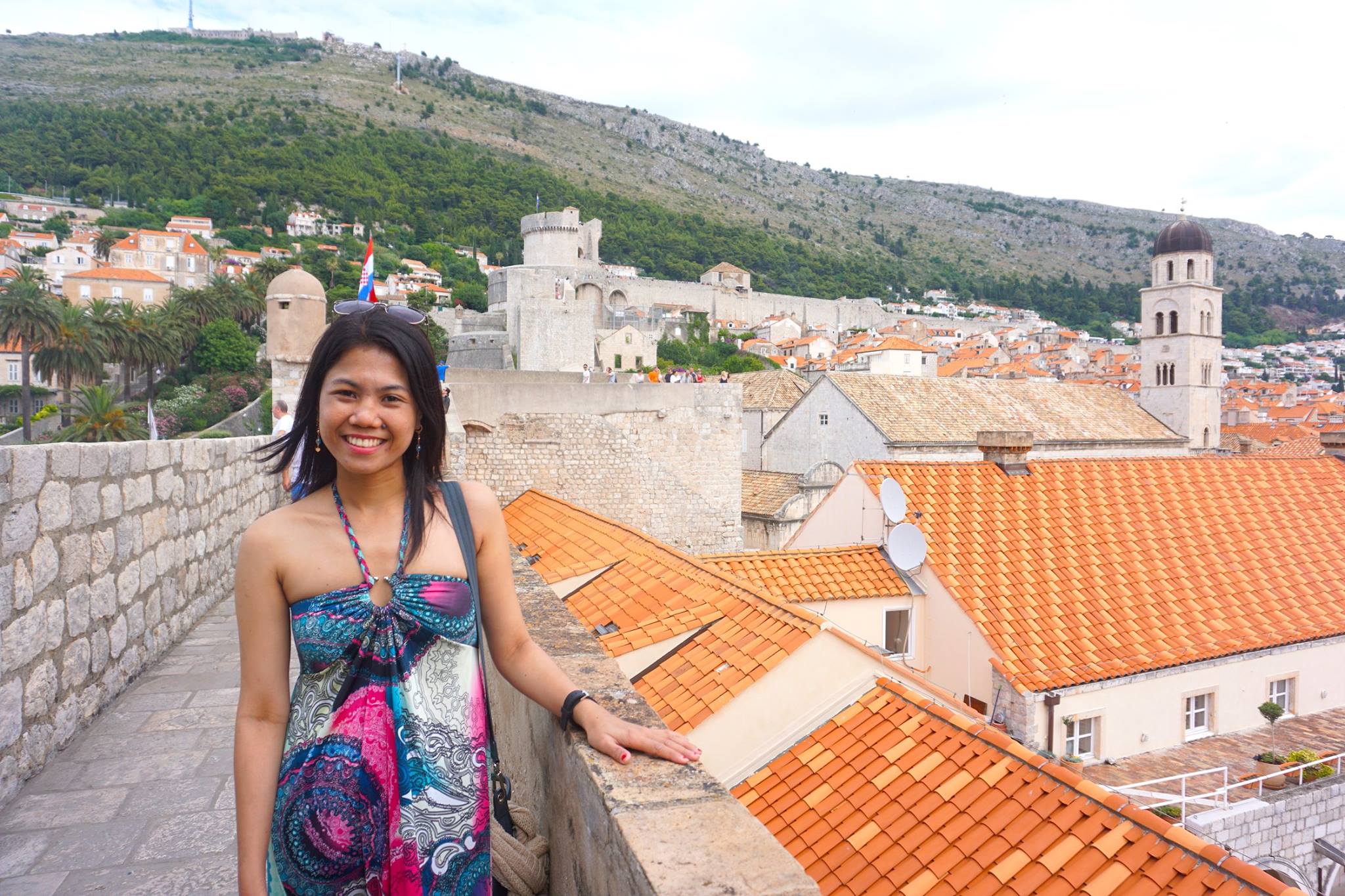
Hi, I’m Christine – a full-time traveler and career woman. Although I’m from the Philippines, my location independent career took me to over 40 countries for the past 8 years. I also lived in 3 continents – from the Caribbean, South East Asia to Africa. But despite living in several countries, my love for Ireland remains the same. A country that had been a part of my life since I was 14 because of my love for Irish music and bands. Ireland Travel Guides was born because of this passion and hopefully, in some little ways, this website will be able to help you on your next trip to Ireland.
Who Invented Halloween? History and Tradition - Ireland Travel Guides
Monday 30th of August 2021
[…] celebrations. Often held during the last night of October, these fun parries are filled with music, dance, drinks, and […]
27 episodes
A podcast dedicated to the world of Irish Dance Music. Presented by Tina Jordan Rees. This episode: May 2016. REELS – Simply Open (Gerry Conlon and Seamus O’Sullivan) SLIP JIGS – Reel Rhythm (Kevin Joyce) PLANXTY DAVIS 109 – Set Dances for Irish Dancing Vol 3 (Sean O’Brien) FIERY NIGHTS – Lord of The Dance (Lord of The Dance Band) PRESENTATION MUSIC – The Féis Album Vol 3 (Anton and Sully)
Irish Dance Music Podcast Tina Jordan Rees
- 4.2 • 9 Ratings
- MAY 28, 2019
A podcast dedicated to the world of Irish Dance Music. Presented by Tina Jordan Rees. This episode: May 2019 RETURN TO LONDON TOWN (REELS): DEVANEY'S GOAT / TOM WARD'S DOWNFALL / THE OLD BLACKTHORN - Chapter 8 (The Kilfenora Céilí Band) MISADVENTURES - Tall Tales & Misadventures (Goitse) KING OF THE FAIRIES - Live Piano Version (Tina Jordan Rees) SULLY'S NO. 6 / HOMAGE TO ROONEY - All Around The World (Gerry Conlon & Seamus O'Sullivan) THE HIGH DRIVE - Keepin' It Reel (Koda) JIG IT: PATSY GEARY'S / THE LEGACY / WALLOP THE SPOT - Now Is The Hour (The Kilfenora Céilí Band) SLIP JIGS, PT. 2 - Irish Dance Music, Vol. 1 (Stephen Walker & Louise Ryan) SHOW TRACK: THE HYNDLAND FOX / VACACIÓN VALENCIANA / THE NEW INN / ARE BUTTONS NOT VEGAN? - Féistastic 4 (Tina Jordan Rees) www.tinajordanrees.com/category/podcast
- APR 30, 2019
A podcast dedicated to the world of Irish Dance Music. Presented by Tina Jordan Rees. This episode: April 2019 REELS 113 - Step Into The Beat: Modern Irish Dance Music (Ellery Klein & Ryan Lacey) REELS 113: TEAM SOLAS / COPENHAGEN CYCLES / OSMOSIS - Féistastic 4 (Tina Jordan Rees) HORNPIPES (113) MICHELLE DEVLIN'S FAVOURITE / MARY MULHOLLAND - Right On Time - Irish Dance Music (Niall Mulligan) DRILLING - Light Up The Dark (The Outside Track) BEGINNERS LIGHT JIG 116 -Step Into The Beat: Modern Irish Dance Music (Ellery Klein & Ryan Lacey) MASTER CROWLEY'S - 13 (Damien Mullane) SLIP JIGS 113, PT. 2 - Feisworld 3 (Alternative Version) (Stephen Walker) THE BAG OF CATS - Each Little Thing (Sharon Shannon) www.tinajordanrees.com/category/podcast
- MAR 28, 2019
A podcast dedicated to the world of Irish Dance Music. Presented by Tina Jordan Rees. This episode: March 2019 MILLHOUSE - The Last Bell (Alan Kelly Gang) PRIMARY REELS (116): MILLIE DOWN THE FOXHOLE / MISS THOMPSON'S - Feistunes 3 (Cormac Ó Sé & Brian O'Sullivan) HORNPIPES - Fire Dance (Gary Currie & Michelle O'Leary) DOLAN'S 6AM - How To Tune A Fish (Beoga) POLKAS (THE LAKES OF SLIGO / LEITRIM RAMBLES / DENNIS MURPHY'S) - Going For Gold (Dean Crouch) REEL FOR RUBIK / TOWARD THE SUN - Ancora (Flook) www.tinajordanrees.com/category/podcast
- FEB 7, 2019
A podcast dedicated to the world of Irish Dance Music. Presented by Tina Jordan Rees. This episode: February 2019 THE ORPHAN - 13 (Damien Mullane) REELS 113 - Real Rhythm (Kevin Joyce) HEAVY JIGS, PT 1 - Irish Dance Music, Vol 1 (Stephen Walker & Louise Ryan) YOUGHAL HARBOUR 110 - Set Dances (Anton & Sully) REELS 113: THE HUMOURS OF WESTPORT / THE STEEPLECHASE / ZOE'S GLOBE - Féistastic 3 (Tina Jordan Rees) HORNPIPES, PT. 1 - Pure Open 2 (Declan Wilson) PIPER'S INN / MOVING CLOUD (IN F) / MOVING COULD (IN G) - 2 Worlds United (Pierre Schryer & Dermot Byrne) www.tinajordanrees.com/category/podcast
- DEC 12, 2018
A podcast dedicated to the world of Irish Dance Music. Presented by Tina Jordan Rees. This episode: December 2018 REELS 114 - Ceili Music For Irish Dancing, Vol. 1 (Sean O'Brien) BANK SET: BANK OF THE ERNE / TRIPOD'S FROLICS - High Spirits (Gráinne Brady & Tina Jordan Rees) BEGINNER HORNPIPES 144: THE HONEYSUCKLE / THE RIGHTS OF MAN - Féistastic 3 (Tina Jordan Rees) REELS: THE HUMOURS OF SCARIFF / THE KILLAVIL'S FANCY / BUCK MORAN'S - All In A Day's Play (Conor Moriarty) JIGS 114 - Ceili Music For Irish Dancing, Vol. 1 (Sean O'Brien) PLANXTY DAVIS (Tina Jordan Rees) REELS 113, PT.2 - Feis World, Vol. 3 (Alternative Version) (Stephen Walker) www.tinajordanrees.com/category/podcast
- SEP 29, 2018
A podcast dedicated to the world of Irish Dance Music. Presented by Tina Jordan Rees. This episode: September 2018 REELS - Simply Open (Gerry Conlon & Seamus O'Sullivan) SLIP JIGS - Fire Dance (Garry Currie & Michelle O'Leary) DOWN SIDE UP - Cherry Blossom Time (Gordon Shand & His Scottish Dance Band) TREBLE JIGS - One Step Closer (Christopher McGrory) CAZADERO - How To Grow A Woman From The Ground (Chris Thile) LIGHT JIGS - The Feis Album (Anton & Sully) BILLIE JEAN - The Singularity (Casey Driessen) www.tinajordanrees.com/category/podcast
Customer Reviews
Thanks Tina!
Top Podcasts In Music
- Submit Story

Irish Dance
Irish dance or Irish dancing is traditional Gaelic or Celtic dance forms that originated in Ireland. It can be performed as a solo or in groups of up to twenty or more trained dancers. In Ireland, Irish dance is part of social dancing or may be for formal performances and competitions.
It is performed traditionally with intricate foot work and is most known for the dancers performing with a stiff upper body. Unlike other dance forms, Irish dancers do not move their arms or hands so that footwork is accented.
CONTENT The History of Irish Dance Irish Dance Music Irish Dance Costumes, Dresses and Shoes Irish Dance Styles & Types Basic Irish Dance Steps Current Trends in Irish Dance Irish Dance Today Frequently Asked Questions Conclusion
The History of Irish Dance
The history of Ireland is also the history of Irish Dance. The actual dates of its origin has never been determined specifically. However, Irish history is steeped in Druidic, Celtic and other religious history which affected the origins of Irish dance. For example, processionals in Druidic and Celtic religious practices required precision movement as do Irish reels and jigs.
The Celts are a 2,000 year old civilization that brought with them their own folk dances. Many of their dances were comprised of circular formations around sacred trees or they consisted of certain patterns performed by males and females in a religious rite.
If there has been any influence in Irish Dance, it may have been the Quadrille . Ireland has been a country of many travelers who brought with them various continental dance styles. The Quadrille was one of these styles that impacted Irish dance.
The Quadrille was popular across Europe in the 18th and 19th centuries when royalty held balls and cotillions. Although, the Quadrille was popular toward the end of the 18th century and spread to England and Ireland around the early 19th century.
A Quadrille is a square dance performed by four couples. It contains five choreographic figures. Each of these figures is a complete dance sequence of itself. Thus, it is easy to see how Irish reels became a prominent part of Irish dance.
Musical instruments like the Irish Bodhran (drum), fiddle, concertina, accordian, Uiliean pipes, Celtic harp, tin whistles and banjo form the background of Irish dance music
Irish Dance Costumes, Dresses and Shoes
In the early days of Irish dance the dance costumes for females were basically ankle length dresses or blouses and skirts. For male dancers, costumes might have consisted of a shirt with a kilt in the Irish clan plaid or it may have been a long coat, shirt, vest and briques (calf length pants) with leggings.
Modern Irish dancers and dancers performing in traditional Celtic dance wear several different costume styles. For Traditional Celtic dance, female dancers wear blouses and long skirts while the male dancers perform with traditional shirt and kilt.
Modern Irish female dancers perform in beautiful short dresses in bright colors, mostly always with their arms fully covered. Modern Irish male dancers perform in trousers and a shirt with a colorful sash tied at the waist.
Shoes for male Irish dancers depends on the type of dance they are performing. For Flat Down step dancing, shoes have metal cleats on the toes and heels. For Ballet Up dance, shoes for males have soft soles.
Female dancers wear black leather "Ghillies" that have soft soles for flexibility for Ballet Up steps. The soft leather of Ghillies help Irish dancers perform dance steps either on the balls of the feet or on tips of their toes.
Female Irish dancers wear two basic types of shoes. For Flat Down step dances, shoes are an oxford style with a thick heel with metal cleat attached to the full heel and a thick frontal sole that also has a metal cleat attached. The oxford is usually black leather, has laces and a leather strap to secure the shoe to the foot.
Irish Dance Styles & Types
In total, there are six Irish dance styles. However, it is equally important to note that within each of the six Irish dance styles, there are basically only two dance style techniques, these are known as Ballet Up and Flat Down. These describe how Irish dancers use their feet in the six styles.
Ballet up describes a balletic style where toes are pointed and steps are performed high on the balls of the feet or on tips of the toes. Body weight is lifted upward from the floor.
Flat Down describes a technique that relies more on the use of the heels in a flat, gliding motion. Body weight sinks downward into the floor to emphasize the sound of the metal cleats.
The six Irish dance styles include:
- Traditional Irish Step Dancing - only the legs and feet move in flat down technique
- Modern Irish Step Dancing - full body movement with ballet up technique
- Irish Set Dancing - with Flat Down technique
- Irish Ceili Dancing - with Ballet Up technique
- Irish Sean Nos Dancing - with Flat Down technique
- Irish Two Hand Dancing - with Flat Down technique
Traditional Irish Step
Traditional Irish Step dancing is performed by male and female dancers in long lines, circles, squares or as partnered reels. Traditional Iris Step Dancing consists of dances set to traditional Irish music with a fast tempo that dancers are required to perform sets of steps to.
For example, two groups of dancers face opposite each other and shuffle, hop, jump, tap and stamp to the music as they more toward each other. Dancers then move between the dancers of the opposite line and then back to their original position. This is often referred to as a "competition" line dance.
Modern Irish Step Dancing
Modern Irish Step dancing has female dancers performing ballet up dance movements like leg swings, hopping and jumping or sashaying to the music. The female dancers perform in soft ghillies while the male dancers are heard tapping in Oxford tap shoes to the music Modern Irish Step Dancing
Modern Irish Step dancing has female dancers performing ballet up dance movements like leg swings, hopping and jumping or sashaying to the music. The female dancers perform in soft ghillies while the male dancers are heard tapping in Oxford tap shoes to the music.
Irish Set Dancing
Irish Set Dancing, as its name implies consists of dances performed in "sets." For example, a performance of Irish Set Dances may be part of a whole choreographed dance performance that is broken up into several separate parts. The set usually requires dancing in couples in four sets.
The Set Dance begins with all four couples dancing to the same choreography. This is followed by each couple performing the same sets as individual couples.
Irish Ceili Dancing
Irish Ceili (pronounced "kay-lee) Dancing is a very traditional dance form. It originated in the 1500's and is always performed to traditional Irish music. The Ceili Dances consist of quadrilles, reels, jigs and long or round dances. These were the most native Irish traditional folk dances.
Irish Sean Nos Dancing
Irish Sean Nos Dancing is one of the oldest of the traditional Irish dance styles. It is the only one performed as a solo. It differs from other Irish dances in that it allows free movement of the arms and it is flat down with the heavy weight on the accented beat of the music.
Sean Nos Dancing is the only Irish dance that also allows the solo dancer to improvise the choreography simultaneously as the dance is performed. The taps consist of shuffles and brushes as the dancer moves across the floor.
Irish Two Hand Dancing
This style of Irish Dance was a predominant part of Irish socializing. It is performed much like Irish Set Dancing with the exception that is it danced to polkas, Irish hornpipes, waltzes and jigs. Like the Irish Set Dancing, it is performed by couples with specific choreographic dance patterns, although in Irish Two Hand Dancing the patterns are repeated.
In Irish Two Hand Dancing couples dance in a relaxed style while they tap their feet in shuffling, hopping and spinning motion. By all appearances, when Irish Two Hand Dancing is performed on a large dance floor, the couples seem to be gliding along as they dance.
Basic Irish Dance Steps
Ballet Up styles of Irish dance rely on several uniformly performed steps. The first comes from the ballet step, "chasse," which means to "chase." In this step the Irish dancer steps with the right foot while the left foot "chases" the right in three counts. This is often called the "1-2-3."
Another step borrowed from Ballet is the "cabriole" which is to leap into the air while the left calf beats under the right calf that is extended forward in the air. There are several other steps that require the dancer to perform full or half turns.
In Flat Down Irish dance steps, the dancer's foot strikes the floor in a twisting shuffle of the right foot while hopping into the air with the left foot.
There are also combinations of Irish dance steps that include the "1-2-3", shuffle, stamping the whole foot and tapping one toe behind the other foot that holds body weight.
Although traditional Irish dance limits movement of the arms, today's modern Irish dancers are seen starting a dance routine with their hands on their hips and using certain movements of the arms that coordinate with music for interpretation of choreography.
Irish Dancers are as young as pre-school age to adult. There are numerous Irish Dance schools that teach traditional and modern Irish dance styles in the U.S. and Europe. The syllabus for Irish Dance is less complex than ballet, although several Irish steps originate from ballet.
Irish Dance is a combination of ballet and tap dancing. Although, it can be said that tap dancing originated from Irish flat down dance technique.
Unlike ballet, however, Ballet Up dance steps require dancers to place full weight on their toes in ghillies that are not blocked as ballet pointe shoes are.
In Flat down dance steps, the shoe is more flexible across the front of the shoe than a traditional tap dance shoe. This enables the Irish dancers to perform shuffling steps with more speed.
Current Trends in Irish Dance
While Irish dance has a rich and traditional history deeply rooted in Irish culture and heritage, it also continues to evolve with modern influences. Some current trends in Irish dance include:
- Incorporation of Contemporary Music: Traditional Irish dance is often performed to traditional Irish music, but contemporary Irish dancers are increasingly exploring choreography set to modern music genres such as pop, rock, etc. This fusion of traditional steps with contemporary sounds adds a fresh and dynamic element to Irish dance performances.
- Innovative Choreography: Choreographers are pushing the boundaries of traditional Irish dance with innovative choreography that incorporates elements of other dance styles such as ballet, jazz, and hip-hop. This blend of techniques creates exciting and dynamic routines that appeal to both traditionalists and contemporary audiences.
- Emphasis on Artistry and Expression: While technical precision remains important in Irish dance, there is a growing emphasis on artistry, expression, and storytelling. Dancers are encouraged to convey emotion and narrative through their movements, adding depth and authenticity to their performances.
- Collaborations with Other Art Forms: Irish dance is increasingly intersecting with other art forms such as music, theater, and visual arts. Collaborative projects between Irish dancers, musicians, and artists are creating multidisciplinary performances that celebrate Irish culture while pushing artistic boundaries.
- Inclusive and Diverse Representation: There is a growing movement within the Irish dance community to promote diversity, equity, and inclusion. Efforts are being made to amplify underrepresented voices, celebrate diverse backgrounds and identities, and create more inclusive spaces for dancers of all ages, genders, and abilities.
- Exploration of New Platforms: With the rise of social media and digital platforms, Irish dancers are exploring new ways to share their artistry with global audiences. Online tutorials, virtual performances, and interactive dance challenges are becoming increasingly popular, allowing dancers to connect, learn, and perform in innovative ways.
Irish Dance Today
The first international reintroduction to Irish Dance performances was with the performance of " Riverdance ", composed by Bill Whelan.
The first performance was in 1995 in Dublin. It starred the now famous Irish Dancer and Irish Dance choreographer, Michael Flatley.
Although, it predominantly features Irish step dancing, "Riverdance" has a Baroque style that incorporates other dance styles like flamenco and a Russian dervish. The end result for dance experts is that "Riverdance" provides insight into how dances are linked in technique and styles.
It has since been performed as a touring Irish Dance show in New York City and at the Vatican for Pope Francis.
In addition to "Riverdance," Michael Flatley choreographed his first full length Irish Dance performance in which he starred, in " Lord of the Dance ." This was followed by " Feet of Flames " and " Celtic Tiger Live ." These are modern Irish dance shows that include Ballet Up and Flat Down Irish dance techniques.
In "Feet of Flames," Michael Flatley performs a lengthy series of movements that seem to defy gravity, all while maintaining balance and musical timing.
However, in the Flatley shows, he included traditional Irish songs in the Gaelic language as well as actual story lines for each of his Irish dance shows. For example, in Lord of the Dance, the story line has both a romantic and a fairy tale plot that includes a whimsical fairy piper.
As a result of the addition of a Gaelic singer and two Irish talented Irish fiddlers in these shows, similar Irish entertainment emerged from these Irish performances such as " Celtic Woman " and " Irish Tenors ."
All of these Irish performances include some of the most extraordinary dance talent and shows the extreme skill needed to maintain Irish dance choreography as well as a semblance of acting talent.
There are also Irish Dance Championships that encourage students of Irish Dance to take part in competitions for awards for their dance techniques, skills and choreography.
Frequently Asked Questions
What is irish dance.
Irish dance is a traditional dance form that originated in Ireland. It is characterized by rapid foot movements, precise steps, and an upright body posture. Irish dance is often performed in groups, with dancers wearing elaborate costumes and performing to traditional Irish music.
What is that Irish dance called?
The term "Irish dance" refers to the various styles of dance that originated in Ireland, including solo and group dances performed to traditional Irish music.
What is the traditional dance of the Irish?
The traditional dance of the Irish encompasses a wide range of styles and forms, including solo dances like the jig, reel, hornpipe, and slip jig, as well as group dances like ceili dances and set dances.

What are the different types of Irish dance?
There are several types of Irish dance, including solo dancing (such as the Irish jig and reel), group dancing (such as ceili dances), and competitive dancing (such as step dancing and Irish dance competitions).
Do I need any previous dance experience to learn Irish dance?
No previous dance experience is necessary to learn Irish dance. Many Irish dance schools offer classes for beginners of all ages, from children to adults. Beginners will start with basic steps and gradually progress to more advanced techniques as they gain experience.
What should I wear to an Irish dance class?
Typically, dancers wear specific attire for Irish dance classes, including soft shoes (ghillies) or hard shoes (jig shoes), as well as comfortable clothing that allows for ease of movement. Some schools may have specific dress codes, so it's best to check with the instructor beforehand.
What is an Irish dance festival called?
An Irish dance festival is typically referred to as a feis (pronounced "fesh"). Feiseanna (plural form) are competitive events where dancers have the opportunity to showcase their skills and compete against others in various categories and age groups.
Is Riverdance Scottish or Irish?
Riverdance is an Irish theatrical show that celebrates Irish culture and dance. It originated as an interval act during the 1994 Eurovision Song Contest and became a worldwide phenomenon, showcasing traditional Irish step dancing alongside contemporary music and choreography.
There is no doubt Irish Dance captures the attention of audiences wherever it is performed. There are also many Irish societies and organizations that help promote Irish dance performances like the Ancient Order of Hibernians, Milwaukee St. Patrick's Day Parade, Friendly Sons of the Shillelagh and the World Irish Dance Organization. Today, Irish Dance is seen in the Thanksgiving Day Macy's Parade as well as the St. Patrick's Day parade in New York City and Chicago.
SIGN UP OR LOG IN TO DANCEUS.ORG
Unfortunately we no longer offer Free plans. Our membership fees are non-refundable as per our Terms . These fees help us maintain & run our site!
Please upgrade your plan to "Organizer" to Add Your School or Venue and Unlimited Events!
Please upgrade quantity in your "organizer" plan to add more schools.

- The History of Irish Dance
Ancient Celtic Dance

Although the exact roots and origins of early Irish dancing are lost in time, there is evidence to suggest a linkage between early forms of Celtic dance and that of modern Irish dance. The Celts were sun worshippers who practiced a pagan dance within a circular formation of stones which has some commonality to the circular formation of Irish set dancing. Celts were also said to have danced clockwise in circles on happy occasions and anti-clockwise when mourning.
They often included movements which involved repeated tapping of the feet on one spot – shades of Sean Nós – and modern solo dancing as well as setting steps in Irish and Scottish group dances.
The earliest reference to dance in Irish history details a visit between the Mayor of Waterford and Mayor of Baltimore. A processional combination of singing and dancing took place called carolling which originated from European folk dance histories and was thought to be introduced to the Irish by the Normans when they arrived in 1169.
The year of 1598 saw dance reels beginning to be published in a work entitled News from Scotland. The reel which is thought to be mostly Scottish in origin was said to be named after the Swedish ragla , which means to stagger, incline or move while walking, first to one side and then the other.
The Irish Jig is widely accepted as Irish in origin and was likely to have originated from an Irish Clan marching tune. The first jig was published by John Playford, a music publisher and choirmaster of St. Paul’s Cathedral in 1986. Queen Elizabeth I was a very public advocate of the Irish Jig.
The three most popular dances mentioned in Irish records from this time include the hay, the rinnce fada (rince is the Irish word for dance) and the rinnce mór. The hay was thought be to circle or chain dance where people would chain in and out of each other in a circle. The first mention of the Irish rinnce fada, which means the long dance, was recorded in 1689 as it was danced in honour of the arrival of James II to Ireland. It was believed he was already familiar with the dance which suggests it was already in practice long before this time.

The Irish people’s love of dancing has been well documented throughout the ages but perhaps John Dunton, an English bookseller and author, put it best when he wrote; ‘on Sundays and Holydays, all the people resorted with the piper to the village green, where the young folk dance till the cows come home. There was no occasion from which dancing was absent’.
The dance of the hornpipe is first mentioned in the time of Henry VIII by Chappell. This dance in particular, is generally excepted by most as being of English origin and is believed to have arrived in Ireland around the 18th century.
1700 – 1800

This era saw the introduction of the Irish Dancing Masters who travelled the country to teach their trade to the masses. They were strongly aware of and influenced by French dancing etiquette manners and deportment. These modern forms of dancing were adapted by the Irish Dancing Masters and passed on to their pupils who came from families of all classes throughout Ireland. The Dance Masters taught a variety of dance principles from simple steps required for crossroad dancing to the more complicated French cotillions and quadrilles, all of which evolved into country set dances, with each locality adding their own characteristics and preferences.
The Gaelic League was founded in 1893. After centuries of British rule in Ireland, the aim of the League was to recreate a separate cultural Irish nation where the use of all English language, culture, games, dress, literature, music and dance was eliminated. While its aims were admirable, the order banned many dances which were popular at the time including round and country dances as well as quadrilles.
The year of 1897 marks the first ever public Ceílí which took place ironically, in London’s Bloomsbury Hall, organised by the Gaelic league, at which sets, quadrilles and waltzes were danced to Irish music.
This year saw the formation of the Gaelic Dancing League which endeavoured to resurrect some of the dances they had caused to disappear. When this was not possible, they composed others in their place. These included the Walls of Limerick and the famous Siege of Ennis.
In 1935, the Public Dance Halls Act was enforced which required all public dances to be licensed and laid down the conditions under which licenses might be issued by district justices. With the act came the end of a way of life in rural Ireland where dances in neighbouring houses were commonplace. Despite another obstacle to the growth of the culture of Irish dancing, the raw nature of set dancing did survive in the parts of Ireland which most valued tradition including counties Clare, Cork and Kerry.

The formation of Comhaltas Ceoltóirí Éireann, meaning the Society of the Musicians of Ireland, which were dedicated to the promotion of music, song, dance and language in Ireland, lead to the strongest revival of interest in traditional Irish music and dance on record. People danced Ceílís and sets across the country and in the years to follow the movement inspired the rise of great Irish Ceílí bands like the Kilfenora, the Tulla, the Aughrim Slopes and the Castle.

In 1970, the birth of the Gaelic Athletic Association, a sub division of Comhaltas organised competitions where teams of dancers from around the country gathered together to share their own style of set dancing to all. This too inspired other communities to foster a pride in their own unique take on Irish dancing and look for and revive their own style of sets.
This decade saw a huge increase of set dancing workshops and set dancing Ceílís around the country of Ireland, with even GAA and ruby halls becoming practice grounds for Irish Dance and its pupils as the infectious nature of the craft captured the hearts of many. This spirit and enthusiasm for the culture of Irish dance is something that still to this day, remains strong in schools and communities across the country.
Research taken from Toss the Feather – Irish Set Dancing by Pat Murphy.

- The First Half
- The Second Half
- Meet The Cast & Crew
- Corporate Events
- Celtic Steps Killarney
- Celtic Steps Tralee
- My Bookings
- Photo Gallery
- Dance Styles
- Dance Techniques
- Cultural Aspects
- Choreography

7 Essential Steps: How to Irish Dance like a Pro
Are you ready to take the stage and capture the essence of Irish dance?
In this article, we’ll guide you through the seven essential steps that will transform you into a pro.
From mastering the basic stance to perfecting graceful arm movements, we’ll show you how to build strength, timing, and rhythm.
With traditional steps and choreography, as well as tips for performances and competitions, get ready to step into the world of Irish dance like a true professional.

Related Video: "BEGINNER SOFT SHOE JIG: Tyler Teaches STEP 1 〡 Learn Irish Dance Tricks & Steps" by Tyler Schwartz Dance
Table of Contents
Key Takeaways
– Focus on proper posture and foot placement – Master basic footwork techniques for success in Irish dancing – Infuse Irish dance routine with unique style and expression – Focus on core stability and flexibility
Mastering the Basic Irish Dance Stance
To master the basic Irish dance stance, it’s important to focus on proper posture and foot placement. The foundation of any successful dance routine lies in maintaining a strong and balanced posture.
Begin by standing tall with your head held high and your shoulders relaxed. Engage your core muscles to support your spine and keep your chest lifted. Imagine a string pulling you up from the top of your head, lengthening your entire body.
As for your feet, they should be positioned parallel to each other, about hip-width apart. Distribute your weight evenly between both feet, keeping your heels down and your toes slightly turned out. This will provide a stable base for your movements.
Maintaining balance while dancing is crucial, and achieving this starts with a solid posture. As you execute steps, remember to keep your body centered and aligned. Avoid leaning too far forward or backward, as this can throw off your balance.
Instead, imagine a straight line running from the top of your head to your toes, and strive to stay within that line throughout your routine. Engaging your core muscles will help you maintain stability and control. Additionally, be mindful of your weight distribution, ensuring it remains balanced between both feet.
Learning the Fundamental Footwork Techniques
Now that you’ve mastered the basic Irish dance stance, it’s time to delve into the fundamental footwork techniques that will take your skills to the next level.
These techniques form the building blocks of Irish dance, allowing you to execute intricate steps with precision and grace.
Basic Footwork Techniques
Mastering basic footwork techniques is crucial for becoming a pro at Irish dancing. These fundamental movements lay the foundation for more advanced footwork variations that will dazzle audiences and impress judges.
To ensure your success in mastering these basics, it is important to avoid common mistakes that can hinder your progress. Here are some key points to keep in mind:
– Proper posture and alignment: Maintain a straight back and engage your core muscles to create a strong and balanced stance.
– Precision and clarity of steps: Pay attention to the placement and timing of your footwork to ensure clean and crisp movements.
– Practice drills: Incorporate drills that focus on specific footwork patterns to improve your accuracy and coordination.
– Partner work: Dance with a partner to enhance your footwork skills through synchronized movements and connection.
Mastering Intricate Steps
Practicing with a partner can greatly enhance your ability to master intricate steps in Irish dance. By working together, you can challenge each other to improve your speed and precision. As you strive for perfection, it’s important to focus on the intricate footwork that sets Irish dance apart. To help you on your journey, here is a table showcasing some of the most common intricate steps in Irish dance:
Adding Personal Flair
By adding your own personal flair, you can infuse your Irish dance routine with unique style and expression. Irish dance is not just about mastering the steps; it’s about showcasing your individuality and passion.
Here are some improvisation techniques and personal style tips to help you stand out on stage:
– Experiment with different arm movements and positions to add grace and fluidity to your performance. – Incorporate small variations in footwork, such as extra taps or quick turns, to add excitement and surprise. – Try incorporating elements from other dance styles, like ballet or contemporary, to create a fusion of styles that is uniquely yours. – Use facial expressions and eye contact to connect with the audience and convey emotion.
By incorporating these improvisation techniques and personal style choices, you can create memorable and captivating Irish dance routines that truly reflect who you are as a dancer.
Now, let’s explore how building strength and flexibility can further enhance your skills on the dance floor.
Building Strength and Flexibility for Irish Dance
To excel in Irish dance, it’s crucial to focus on building both core stability and flexibility. Core stability plays a key role in maintaining proper posture and control throughout the intricate footwork and movements.
Core Stability for Flexibility
You’ll need strong core stability to improve your flexibility for Irish dancing like a pro. Your core muscles, including your abdominals, back, and hips, play a crucial role in supporting your body during intricate footwork and jumps.
To enhance your core stability and increase your flexibility, try incorporating the following exercises into your training routine:
– Plank variations: Perform front, side, and reverse planks to target different areas of your core and build overall strength. – Pilates exercises: Engage your core muscles through movements like the hundred, roll-ups, and leg circles.
Benefits of flexibility training:
– Increased range of motion: Improved flexibility allows you to execute dance steps with greater precision and grace. – Reduced risk of injury: Flexible muscles and joints are less prone to strains and sprains, keeping you safe while dancing.
By focusing on core stability and flexibility, you’ll be well on your way to mastering the intricate footwork and fluid movements of Irish dance.
Keep pushing yourself and enjoy the journey towards becoming a pro.
Targeted Muscle Strengthening Exercises
To strengthen specific muscles for improved flexibility, try incorporating targeted exercises into your training routine. By focusing on different muscle groups through resistance training, you can enhance your overall dance performance and prevent injuries. Here are some effective exercises that will help you develop strength and flexibility in key areas:
Perfecting the Graceful Arm Movements
Mastering the graceful arm movements in Irish dance requires practice and precision. These arm movements are an essential component of the dance, adding elegance and fluidity to your performance. To perfect your arm movements, focus on arm positioning and synchronization with your footwork.
Here’s how you can achieve that:
– Arm Positioning : – Keep your shoulders relaxed and down, allowing for free movement of your arms. – Maintain a slight bend in your elbows, avoiding stiffness or excessive bending. – Keep your wrists straight and aligned with your forearms, creating a seamless line from your fingertips to your shoulders.
– Synchronization with Footwork : – Coordinate your arm movements with your footwork, ensuring a harmonious flow. – Use your arms to create graceful lines and shapes that complement the rhythm and style of the dance. – Pay attention to the timing of your arm movements, matching them with specific steps or beats in the music.
By practicing these arm movements with precision and dedication, you will enhance the overall beauty and finesse of your Irish dance performance. Remember, it takes time and effort to master the art of graceful arm movements, but the results are well worth it.
Understanding the Importance of Timing and Rhythm
Understanding the importance of timing and rhythm is crucial in achieving a seamless and captivating Irish dance performance. As a dancer, you need to possess a strong sense of musicality and be able to find the right rhythm within the music. Irish dance is characterized by its lively and energetic movements, and it is the rhythm that drives these movements and gives them their unique flair.
Musicality is the ability to interpret and connect with the music, allowing it to guide your steps and movements. It is about feeling the music in your body and moving in harmony with the beat. By understanding the musical structure and patterns, you can anticipate the changes in tempo and adjust your steps accordingly.
Finding the right rhythm requires practice and attention to detail. You need to listen carefully to the music and identify the underlying beat. Once you have established the rhythm, you can then synchronize your movements to it. This synchronization creates a visual and auditory harmony that enhances the overall performance.
Not only does timing and rhythm add precision and finesse to your Irish dance, but it also helps you connect with the audience on a deeper level. When your movements are perfectly in sync with the music, it creates an enchanting and captivating performance that leaves a lasting impression.
Exploring Traditional Irish Dance Steps and Choreography
Get ready to step into the world of traditional Irish dance as you explore the intricate footwork and captivating choreography. Traditional Irish dance steps have a rich history and are influenced by the vibrant traditional music of Ireland.
Here are some key elements to consider when delving into this enchanting dance form:
– Solo Dances : These dances are performed individually and showcase the dancer’s technical skills and agility. Examples include the *Light Jig*, *Single Jig*, and *Hornpipe*. Each dance has its unique rhythm and tempo, allowing dancers to express their personality and style.
– Group Dances : Group dances, such as *Ceili* and *Set Dancing*, bring people together in synchronized movements. These dances have a strong historical significance, as they were often performed during social gatherings and celebrations in rural communities. The intricate formations and patterns create a mesmerizing visual spectacle.
Traditional Irish dance steps and choreography have evolved over centuries, reflecting the cultural heritage and storytelling traditions of Ireland. The dances are deeply rooted in the history of the Irish people and serve as a link to their past.
Now that you have a glimpse into the world of traditional Irish dance, let’s dive deeper into the tips and tricks for performance and competitions.
Tips and Tricks for Performance and Competitions
Now let’s delve into some helpful tips and tricks for performing and competing in traditional Irish dance.
When it comes to performance preparation, it’s crucial to start with a solid warm-up routine. Stretch your muscles and focus on strengthening your core to improve your technique and prevent injuries.
Practice your routines regularly, paying close attention to the details of each step. This will not only help you perfect your moves but also build your confidence on stage.
Costume and appearance play a significant role in Irish dance. Make sure your costume is clean, well-fitted, and in good condition. Your appearance should be tidy and polished, with hair neatly styled and makeup applied appropriately. Remember, the right presentation can make a lasting impression on the judges and audience.
While performing, maintain a strong posture and engage your core muscles. Keep your arms relaxed and your upper body steady, allowing the focus to be on your footwork. Project enthusiasm and energy through your movements, captivating the audience with your passion for Irish dance.
During competitions, it’s essential to stay focused and calm. Take deep breaths and visualize yourself performing flawlessly before stepping on stage. Embrace any mistakes as learning opportunities and perform with grace and confidence.
Frequently Asked Questions
What are some common mistakes beginners make when learning the basic irish dance stance.
When learning the basic Irish dance stance, beginners often make common mistakes. One of these is not maintaining proper posture. Remember to keep your back straight, shoulders relaxed, and chin up for a strong and graceful stance.
How Long Does It Take to Become Proficient in the Fundamental Footwork Techniques of Irish Dance?
On average, it takes time and dedication to become proficient in the fundamental footwork techniques of Irish dance. By following proper training techniques, you can master these skills and dance like a pro.
Are There Any Specific Exercises or Stretches That Can Help Improve Strength and Flexibility for Irish Dance?
To improve strength and flexibility for Irish dance, incorporate exercises and stretches into your routine. Focus on exercises that target your core, legs, and ankles, and stretches that elongate your muscles. This will help you dance like a pro.
How Can I Ensure That My Arm Movements Are Graceful and Synchronized With the Footwork?
To ensure your arm movements are graceful and synchronized with the footwork, focus on maintaining proper arm posture and coordinating your arm movements with your steps. This will help you achieve a polished and professional Irish dance performance.
Can You Provide Any Tips for Maintaining Consistent Timing and Rhythm While Performing Irish Dance?
To maintain consistent timing and rhythm in Irish dance, focus on the music. Feel the beat and let it guide your movements. Sync your footwork and arm movements with the music for a graceful and synchronized performance. Musicality is key!
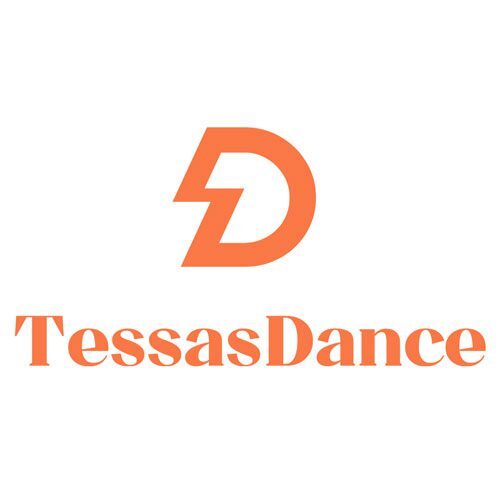
6 Simple Steps to Salsa Dance: How to Salsa Dance?
6 Easy Steps: How to Shuffle Dance?
6 Simple Steps to Learn How to Swing Dance
Join Our Newsletter
Signup to get the latest news, best deals and exclusive offers. No spam.
10 Essential Tips for Mastering Pole Dance
Spotify is currently not available in your country.
Follow us online to find out when we launch., spotify gives you instant access to millions of songs – from old favorites to the latest hits. just hit play to stream anything you like..

Listen everywhere
Spotify works on your computer, mobile, tablet and TV.

Unlimited, ad-free music
No ads. No interruptions. Just music.

Download music & listen offline
Keep playing, even when you don't have a connection.

Premium sounds better
Get ready for incredible sound quality.

- My presentations
Auth with social network:
Download presentation
We think you have liked this presentation. If you wish to download it, please recommend it to your friends in any social system. Share buttons are a little bit lower. Thank you!
Presentation is loading. Please wait.
Guide to Irish Traditional Music
Published by Christine Holst Modified over 4 years ago
Similar presentations
About project
© 2024 SlidePlayer.com Inc. All rights reserved.
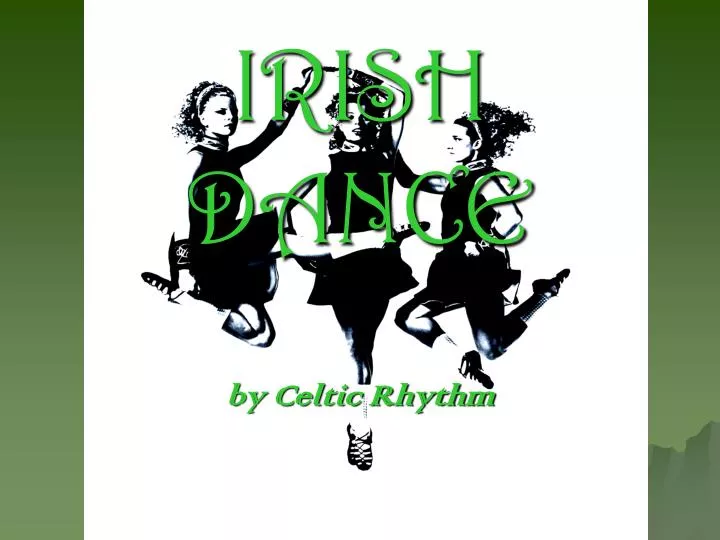
IRISH DANCE
Oct 03, 2014
200 likes | 946 Views
IRISH DANCE. by Celtic Rhythm. HISTORY. First references: druidic practice During the 12 th century dance and music were prohibited 16 th and 17 th century - “crossroads dancing” becomes popular 18 th century – traveling Dance Masters
Share Presentation
- irish dance
- celtic rhythm
- century dance
- modern irish dance
- set dance french influence

Presentation Transcript
IRISH DANCE by Celtic Rhythm
HISTORY • First references: druidic practice • During the 12th century dance and music were prohibited • 16th and 17th century - “crossroads dancing” becomes popular • 18th century – traveling Dance Masters • 19th century - the Irish Dancing Commission founded, to establish rules in teaching, judging and competitions • 20th century – Irish dance becomes popular worldwide (Riverdance, Lord of the Dance, Michael Flatley)
FORMS & TYPES OF DANCES • Solo • Figure or céili, originally danced at house dances • Jig: several types (light jig, slip jig, heavy jig, etc.), both dance and dance tune, usually in 2/4 time but 6/8 time is also very common • Reel: any dance danced to music in reel time (either as 2/2 or 4/4 ); danced in soft shoes ; one of the first dances taught to beginners • Hornpipe: danced in hard shoes in 2/4 time, very popular with sailors in 17th and 18th century • Set dance: French influence, danced in so-called figures, ranging in number from 2 to 9
COSTUMES footwear Hard shoes (jig shoes) Wood, fiberglass First tips made by wood with metal nails Soft shoes Black leather, flexible Reel shoes soft shoe worn by male dancers
Solo dresses • Very expensive • unique • Use of many colours from the nature • Team dresses • More designs on the front than on the back • Use of just a few colours (mainly traditional Irish colours green, yellow, orange)
Wigs and tiaras
Modern Irish dance Combines show dance, arm and facial expression with the elements of traditional dance forms Lord of the dance Celtic Tiger Riverdance
CELTIC RHYTHMBelgrade Kursevi irskog plesa Upis tokom cele godine [email protected] 064/086 085 3
- More by User

Irish 226: Irish Literature
Irish 226: Irish Literature. Introduction to Irish History John Rickard Bucknell University. Irish Geography. Ireland is an island located at the far Western edge of Europe in the Atlantic Ocean. Map of Ireland.
833 views • 51 slides

Irish Dance
Irish Dance. By Gene Kelly. History of Irish Dance. Although the history of Irish dance is vague, evidence points to the ancient Druids (Priests) as using dance in religious ceremonies to honour the Oak tree and the Sun around 300 BC. Types of Irish Dance. Ceili Dances
240 views • 4 slides
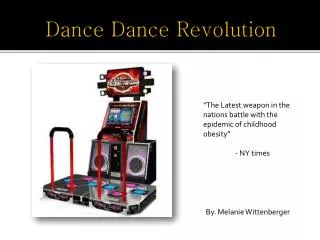
Dance Dance Revolution
Dance Dance Revolution. “The Latest weapon in the nations battle with the epidemic of childhood obesity” - NY times. By. Melanie Wittenberger. How does DDR work?.
542 views • 11 slides

tunepal.org – The google of traditional Irish dance music
tunepal.org – The google of traditional Irish dance music. Dr Bryan Duggan Prof Brendan O’ Shea Dr Mikel Gainza Prof Padraig Cunningham(UCD) School of Computing DIT Kevin St [email protected] http://www.comp.dit.ie/bduggan/music http://tunepal.org. Overview.
493 views • 29 slides
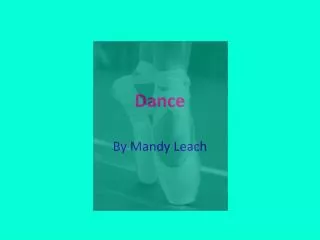
Dance. By Mandy Leach. Preview. Popular culture and dance Dance history Tango, swing, ballet, break dance Dance movies Dance movies and popular culture Dance TV shows: So You Think You Can Dance, Americas Best Dance Crew, Dancing with the Stars . Intro.
689 views • 16 slides

Dance . Instructors: Maria Priya. Equipment. TV DVD Mats Dance shoes Water Energy drinks Stereo system Sweats . Performed in. Dance Room Dance room requirements Floor to ceiling mirrors Springy wood floor. Safety Concerns. Stretch Can pull a muscle
359 views • 10 slides

Dance Dance World Solution
Dance Dance World Solution. D. Dance Dance World Solution CASTILLEJA KISARUNI 6 th grade girls Write custom lyrics to a song Include song in a “time capsule” for Kisaruni 11 th grade girls Deliver time capsule to Kisaruni as part of their junior-year trip
288 views • 1 slides
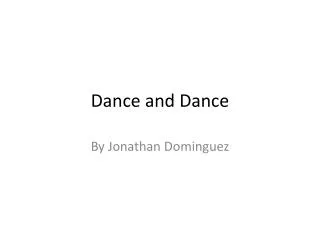
Dance and Dance
Dance and Dance . By Jonathan Dominguez. You can dance in a rug with your socks on. Opps I meant to do that. Here is a battle. The beaters vs. the mopes.
377 views • 4 slides
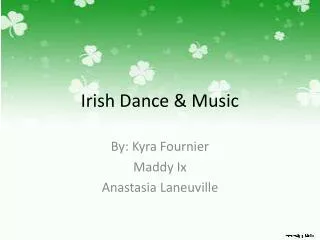
Irish Dance & Music
Irish Dance & Music. By: Kyra Fournier Maddy Ix Anastasia Laneuville. Irish Dance. Performed at weddings, fairs, on holidays and other social gatherings Early 1700s, the ‘Travelling Dance Master’, appeared in Ireland An educated man, who taught dance for a living
485 views • 10 slides

Irish Heritage Christmas Feis Sponsored by The O'Shea-Chaplin Academy of Irish Dance
Entry Form Irish Heritge Christmas Feis Sunday, December 11, 2011 Entrees due by November 14th. No telephone, email or entrees on the day of the feis will be accepted . No changes will be made after Nov. 21 st . Entrees
234 views • 2 slides

Dance Dance Education
Dance Dance Education. A Guide for Teachers to Bring Dance into Physical Education. Nicole Cavallo. AAHPER….. D?. Dance commonly absent from Physical Education Why ? Teachers lack a dance background Schools do not enforce dance curriculum Teachers not educated in health benefits.
789 views • 20 slides

Jaymi Moore. Summer Hirtzel. Priscilla Herrera. Marissa Provost. Amanda Sheehan. Dance Dance Revolution. Origins of DDR.
797 views • 7 slides

Dance. Part of the Arts & Humanities Core Content. Altered for use with 5 th grade students at Perryville & Junction City Elementary Schools, 2005, by Lori Theaker, MSLS. http://hometown.aol.com/tapestrylj/TAPESTRYSITE/Colonial.html.
695 views • 18 slides
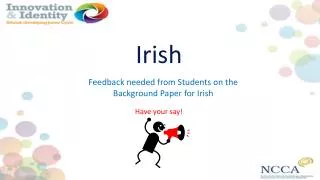
Feedback needed from Students on the Background Paper for Irish. Have your say!. Irish. Attention!!!. Irish as a school subject is changing ! Learn about those changes. Discuss them with your friends. Share your thoughts on the Irish course with us. Irish in the Junior Certificate.
383 views • 6 slides

DANCE. Refers to movement of the body, usually rhythmic and to music It is dependent on social, cultural, aesthetic and moral constraints. Uses of dances. As a form of expression Social interaction Presented in a spiritual or performance setting
820 views • 47 slides

Irish Dance Music
Dancing is part of every culture and Irish culture is no different. Our historical records do not show the music or the dance steps but we do know the names of several types of dances for example “The sword dance” and “The Haye”. Irish Dance Music.
854 views • 18 slides

Dance Dance PowerPoint Arrows
Dance Dance PowerPoint Arrows. Step in the direction of the arrow. Step in the direction of the arrow. Step to the corners. Both feet move at the same time in the direction of the arrows. Jump with both feet from side to side. Criss-. Cross. Jump with both feet to the corners.
1.51k views • 112 slides
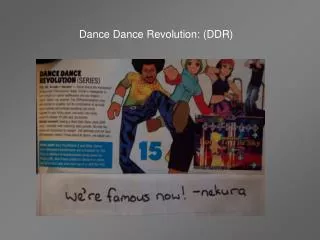
Dance Dance Revolution: (DDR)
Dance Dance Revolution: (DDR). DDR: DDR has brought video games into dance culture. That's the revolutionary part of Dance Dance Revolution. the game looks like a combination of high-impact aerobics.
445 views • 6 slides

Dance Dance Revolution. By: Chris Garcia. Equipment needed…. Gymnasium- to provide the essential space needed for the whole class to participate in the game. Equipment needed…. Projector/ TV screen to view the video game in the gym so everyone participating can view the game.
592 views • 10 slides
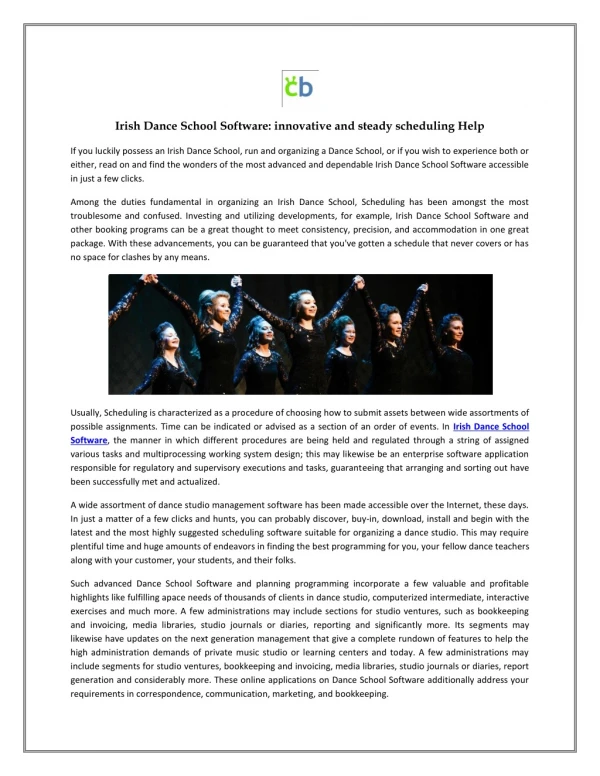
Irish Dance School Software: innovative and steady scheduling Help
Find the features of Irish Dance School Software that help dance educators to make the most of their professions and organizations.
21 views • 2 slides

Embroidered Irish Dance Bags
https://kelsocustomcovers.com/product-category/garment-bags/ Made of lightweight and water-repellent 420-denier material, the single-sided Irish Dance dress garment bag has a durable zipper, and webbed handles for hanging and carrying. An interior pocket divided in three sections holds your accessories and personal items.
30 views • 1 slides

Irish Dance School in Florida
Number one rated Irish dance studio in Orlando with over 120 students competing in the highest standard. Central Florida Irish is perfect for all ages! Visit us: https://www.centralfloridairishdance.com/
84 views • 8 slides

Fleadh Cheoil na hÉireann will showcase Wexford’s rich tradition of music, song and dance
W exford Fleadh Executive Committee and Comhaltas Ceoltóirí Éireann officially launched Fleadh Cheoil na hÉireann 2024 at the National Opera House, Wexford on Sunday, March 31.
Wexford Town will come alive with Fleadh Cheoil na hÉireann, the world’s largest celebration of Irish traditional music and heritage from August 4 to August 11. The event, organised by Comhaltas Ceoltóirí Éireann and hosted by the local committee, is expected to draw over half a million visitors to County Wexford.
“We're honoured to have our beloved town play host to this year's Fleadh Cheoil na hÉireann. This celebration is a tribute to the volunteers, businesses, musicians, Comhaltas branches, and the global community, all of whom will contribute to making this year's event unforgettable. The Fleadh is a festival for everyone, inviting both those who have experienced a Fleadh before and those who have yet to discover its magic. We’ve been working towards this Fleadh for many years, and we can't wait to showcase the rich Wexford culture of music, song and dance with the world,“ said Cathaoirleach of the Fleadh Executive Committee, Eddie Taaffe.
This year's theme of 'A Fleadh for All' embodies the festival's spirit of inclusivity and diversity. The Fleadh will host an international audience and feature a diverse line up of 15,000 musicians, dancers, singers and storytellers from various communities across Ireland. With an exciting and varied programme that caters to all tastes, there's something for everyone at Fleadh Cheoil na hÉireann 2024. The recent launch displayed the cultural experiences in store for attendees this August.
Wexford Town, nestled in Ireland’s Ancient East, offers more than just a picturesque backdrop for the celebrations. Attendees are encouraged to explore the wider county, with its sprawling coastline, bustling towns, and rich history.
“As proud event partners, Fáilte Ireland is thrilled to celebrate the Fleadh Cheoil 2024 in Wexford this August! Rolling out the red carpet for visitors from near and far, we’re looking forward to welcoming visitors to the Fleadh and sharing all the wonders of Ireland's Ancient East," said Fáilte Ireland Tourism Officer for Ireland’s Ancient East, Aileen Dowling.
The Irish diaspora stretches to 80 million people worldwide. Fleadh Cheoil na hÉireann, the largest event of its kind, serves as a melting pot of culture, of people coming together to celebrate traditional music and Irish heritage from across the world. For the Fleadh Cheoil na hÉireann 2024, visitors can expect lively sessions in quiet pub corners, dancing, singing, and on-street performances, with céilí bands galore. This year is set to feature many highlights, with the eagerly anticipated traditional music and dance competitions serving as high points in the week.
“The 2024 Fleadh Cheoil na hÉireann promises to be one the most spectacular Fleadhanna of all time. Against the backdrop of historic Wexford famous in music, song and story up to 600,000 Fleadh fans from all over the world will assemble for one of the greatest cultural festivals in the world. The economy will benefit by over €60,000,000, and Irish culture will be substantially enhanced,” said Director-General of Comhaltas Ceoltóirí Éireann, Labhrás Ó Murchú.
Fleadh Cheoil na hÉireann is supported by Wexford County Council, Fáilte Ireland and Wexford Credit Union. RTÉ and TG4 will once again act as broadcast and live broadcasting partners respectively.
Get ahead of the day with the morning headlines at 7.30am and Fionnán Sheahan's exclusive take on the day's news every afternoon, with our free daily newsletter.

IMAGES
VIDEO
COMMENTS
Get ready to experience the spirited rhythms and heartwarming melodies of Ireland with "Celtic Reels: An Irish Folk Dance Celebration." This captivating musi...
Reel music. Whether in pubs or on the street, the Reel is above all a popular dance and music, played on all occasions and in all places. With a clearly defined structure, it is written in 4/4 or 2/2 time, and consists of a trill movement with an accent on the first and third beats. Each musical phrase is played over eight bars, and is based on ...
Dean Crouch, album Top BoxMore Irish dance music: http://www.youtube.com/playlist?list=PL-GUcy1PiMMPD4AyeyMM97cmHuKYTIC_9&src_vid=Yc09D6a3w-0&feature=iv&anno...
Irish Dance Music The Reel • The reel originated in Scotland. • It is a fast dance in 2 4, 4 4 or 2 2 time. • A typical rhythm is 2 groups of 4 quavers. • The round is played two/three times before a new reel is introduced. • Example: The Rakes of Mallow. Irish Dance Music Hornpipe • This dance is of English origin.
In Irish dance, dancers use their entire body to execute precise footwork while maintaining a straight posture and keeping their arms at their sides. The most basic move in Irish dance is the 'Over 2-3′, which involves hopping onto one foot, bringing the other foot up behind it, and then stepping onto that back foot.
Presentation Transcript. Irish Rock • Rock and roll became popular in the 60s in Ireland • The British Invasion, while big in the United States, was also big in Ireland • Van Morrison put Irish Rock music on the charts • Songs: Have I Told You Lately That I Love You, Brown Eyed Girl, Moondance, etc. • The most influential band that ...
The reel - The most well-known Irish dance music, the reel is either 2/4 or split common time (a quick 4/4 with primary powerful beats) and has two beats in each bar. The majority of the movement is done in quavers. Two or three tunes are combined, with each tune being repeated two or three times before going on to the next.
FIERY NIGHTS - Lord of The Dance (Lord of The Dance Band) PRESENTATION MUSIC - The Féis Album Vol 3 (Anton and Sully) Irish Dance Music Podcast Tina Jordan Rees Music 4.2 • 9 Ratings; A podcast dedicated to the world of Irish Dance Music. ... SLIP JIGS, PT. 2 - Irish Dance Music, Vol. 1 (Stephen Walker & Louise Ryan)
Irish Ceili Dancing. Irish Ceili (pronounced "kay-lee) Dancing is a very traditional dance form. It originated in the 1500's and is always performed to traditional Irish music. The Ceili Dances consist of quadrilles, reels, jigs and long or round dances. These were the most native Irish traditional folk dances.
1686. The Irish Jig is widely accepted as Irish in origin and was likely to have originated from an Irish Clan marching tune. The first jig was published by John Playford, a music publisher and choirmaster of St. Paul's Cathedral in 1986. Queen Elizabeth I was a very public advocate of the Irish Jig.
violin. For Irish music, it is tuned the same, low to high string: G, D, A, E. The term "fiddle" is used when referring to traditional or folk music. The fiddle is one of the primarily used instruments for traditional Irish music and has been used for over 200 years in Ireland. The medieval fiddle originated in Europe in
Remember, the right presentation can make a lasting impression on the judges and audience. While performing, maintain a strong posture and engage your core muscles. Keep your arms relaxed and your upper body steady, allowing the focus to be on your footwork. ... To maintain consistent timing and rhythm in Irish dance, focus on the music. Feel ...
The Fusion Fighters Street Performance Crew Back In Action on St Patrick's Day in Temple Bar, Dublin! ☘ 🇮🇪☘Join this channel to get access to perks:https:...
Irish Dance Music: Reels 113 · Playlist · 99 songs · 255 likes. Irish Dance Music: Reels 113 · Playlist · 99 songs · 255 likes. Home; Search; Resize main navigation. Preview of Spotify. Sign up to get unlimited songs and podcasts with occasional ads. No credit card needed. Sign up free-:--Change progress-:--
14 End of Slideshow. Download ppt "Guide to Irish Traditional Music". Origins Music has been in Ireland for thousands of years. The first inhabitants of the island used very primitive forms of musical instruments, mostly pipes and horns. Rather than being used to make melodies or as a form of art, instead they were most likely used as ...
Presentation Transcript. Socio-political place of Irish traditional music • Irish traditional music key symbol of Irish nationalism. • Large group of aficionados and enthusiasts in Ireland, supported in principle by the population • Combination of conservative social tradtion and musical innovation and adventurousness • Cf "Country ...
Irish dance carries with it echoes of many other cultures with which the people of Ireland have interacted. Steps of Freedom features some of the form's finest dancers, including Jean Butler ...
Recorded on July 16, 2013 - Traditional Irish Night in the Corn-Barn at Bunratty Folk Park.
Presentation Transcript. IRISH DANCE. by Celtic Rhythm. HISTORY. First references: druidic practice During the 12 th century dance and music were prohibited 16 th and 17 th century - "crossroads dancing" becomes popular 18 th century - traveling Dance Masters Slideshow 5092448 by base.
Wexford Town will come alive with Fleadh Cheoil na hÉireann, the world's largest celebration of Irish traditional music and heritage from August 4 to August 11. The event, or...
Mar 25, 2024. Kaitlyn Sardin performing her original Irish dance fusion choreography. Kaitlyn Sardin, X. Irish dancer Kaitlyn Sardin, 26, is a bit shocked by the negative reactions to her latest ...
Three lads, Ronan O'Connell, Dara Kelly and Francis Fallon, share the Christmas spirit with brillant choreography to God Rest Ye Merry Gentlemen at the Hessi...